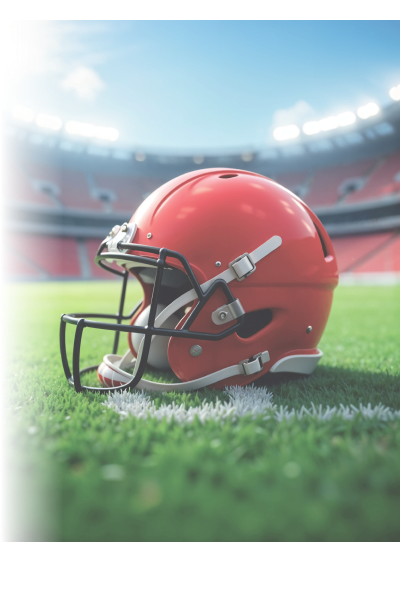
NFL Beginners Breakdown: Basic Breakdown of the NFL and Super Bowl LVII

Andy Robson
Andy Robson is the most popular betting tipster in the UK. With a combined following in excess of 1 million people across his social media channels, Andy has built a loyal audience by consistently providing quality betting content for over nine years. He is the founder of Andy’s Bet Club, which he launched in 2019.
As the Super Bowl draws ever closer, the excitement levels are building across America and the World for the Eagles v Chiefs matchup. In what should be a thrilling matchup there is plenty of value in the betting markets. We have constructed a Cheat Sheet to assist with your bets but there is terminology which new fans of the sport may not be familiar with. In order to best understand and make use of our cheat sheet attached, here is a breakdown of the basics of the sport and the Cheat Sheet.
Super Bowl LVII Cheat Sheet

Introduction to the NFL
An NFL roster is made up of 53 players with 11 starters on offence and 11 starters on defence. The offence is made up of usually 5 offensive lineman, who are there to block, the quarterback who is there to throw the ball and sometimes run when under pressure, and then usually 5 skill position players. Skill position players are the running back who primarily rushes the ball, the receivers are there to catch the balls from the QB and the tight end who is usually bigger and can therefore block or line-up as a receiver.
The 11 personnel on defence have a largely flexible formation and often need to rotate to rest which is why time of possession is essential. The defensive lineman, usually 3 or 4 of them, are there to stop the run or rush the quarterback attempting to bring him down. Cornerbacks are there to guard the receivers, helped by safeties who line up deeper if coverage is blown. 2 or 3 linebackers finish off the defence who are there to help in coverage, rush the QB, or stop the run. Compare them to a box to box midfielder in football who can perform multiple skills to a high level.
The aim is to score points, simple right? The field is 100 yards long and the aim is to score a touchdown worth 6 points. When a team gets the ball, they start in 1st & 10 which means first down and 10 yards to go. They have to move the ball at least 10 yards on 4 plays to keep the ball. Fail to gain the 10 yards and the ball is turned over to the opposition. Gain at least 10 yards and they reset to 1st down and can continue trying to score.
Often a team on 4th down will “punt” the ball as far down the field to make the opponent have to try and drive from further back. Alternatively, if they are close enough, they can kick through the uprights for 3 points.
The Quarterback – Passing Yards
The quarterback is the heart of the offence and arguably the most important position on the roster. It’s no surprise that the Super Bowl features two of the best QB’s in the league and arguably the front runners for MVP. The QB is there to pass the ball and it’s extremely rare to see anyone else passing the ball.
From a betting standpoint, we can bet on Yards, Attempts, Completions and Passing TD’s. 'Passing Yards' is how many yards the ball travels from the line of scrimmage (where the play starts) including after the catch before the receiver is tackled. ‘Attempts’ is how many times the QB throws the ball and ‘Completions’ is how many times he connects with a receiver. The final leg is ‘Passing Touchdowns’ which is how many times he connects with a receiver in the endzone. As we can see on the Cheat Sheet, Mahomes averages an exceptional 2.41 to Hurts 1.46. However’ Hurts offers another threat which we’ll touch on later.
Rushing Yards
We’ve spoken about passing the ball, but teams can also call run plays which result in ‘Rushing Yards’. Rushing is where the player runs from behind the line of scrimmage with the intent of gaining yards and is measured on how many yards are gained or lost.
Often rushing plays are called on 1st down or short yardage situations as they usually pick up consistent small yardage as opposed to chunk plays. Often rushing yards are collected by the running backs, e.g., Miles Sanders and Isiah Pacheco.
Rushing yards can also be collected by dynamic wide receivers such as Kadarius Toney and more importantly in this game, quarterbacks. When the defence pressures the quarterback, often they escape and try to rush themselves or can have designated run plays called QB Draws. Jalen Hurts is arguably the best rushing QB in the league. Hurts average 50 yards per game which is extremely high for a QB.
Receiving Yards
The skill positions/pass catchers are made up of wide receivers, tight ends and running backs who all can earn ‘Receiving Yards’. Every catch is called a reception and receivers can earn yards after their reception which count until they are tackled down. Travis Kelce is in a world of his own for tight ends in terms of receptions and yards this season, while A.J. Brown is a dominant receiver with a big physique allowing his to overpower smaller cornerbacks.
Sacks
The defence can ‘Sack’ the quarterback which is where he is tackled prior to reaching the line of scrimmage. The defensive line and line-backers record sacks, and the Eagles are arguably the best team in the league at recording them, with 70 in the season, 3rd all time. The next play is taken from where the QB is tackled, therefore often resulting in a heavy loss of yardage for the offence and sometimes a turnover if he fumbles the ball.
The offensive lineman are trying to block the defenders from hitting their QB and allow less pressure. A low pressure rate is good for the team but a high pressure rate is good for any bets as they are more likely to allow sacks.
Interceptions
Another way the defence can turn the ball over is via an ‘Interception’. When the quarterback throws the ball, the cornerbacks, safeties and line-backers guarding the receivers are trying to stop them catching it, but they can also catch the ball themselves - an interception. If a defensive player catches the ball, they can return the ball as far as possible until tackled.
Snap Counts
Another stat we have on our Cheat Sheet is snap count %. Every play is a ‘Snap’ and teams rotate their players on and off the field. There are 53 of them, 48 dressed to play, after all!
Quarterbacks are expected to play 100% of snaps and Mahomes/Hurts are only lower due to injury. Running backs often rotate and off regularly and the Eagles' 3 running backs exemplify this. Sometimes head coaches run plays with different personnel which can lead to more or less receivers, more tight ends and even no running back which is why snap counts are less than 100%. In essence it’s % of time spent on the field on offence.
18+ please gamble responsibly.




